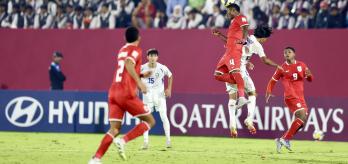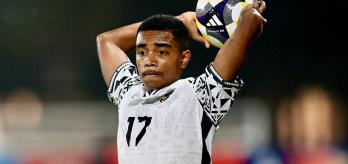During FIFA U-17 World Cup Qatar 2025™, our Technical Study Group (TSG) is reporting a notable increase in the use of long throw-ins direct to the penalty area to create goalscoring opportunities.
These observations are evidenced by the data from our Football Performance Insights Team, showing that 19% of all throw-ins taken in the opening 48 matches, in the top quarter of the pitch, were thrown long, directly into the penalty area. This compares to 6% in FIFA U-17 World Cup Indonesia 2023, showing the notable increase of 13%. Of the 48 teams competing in Qatar, 37 have utilised long throws into the penalty area.
Generating goalscoring opportunities
Set plays in the final third offer teams a key attacking threat and an opportunity to execute a pre-rehearsed phase of play. Like corners and free kicks, the pre-planned nature of these throw-ins can give the attacking team a major advantage in timing, due to knowing what’s coming, while the defending team has very little time to react.
In their opening two matches, Mexico launched eleven throw-ins direct into the penalty area, generating two attempts at goal within 7.5 seconds of the throw-in being taken. They did not always throw the ball direct into the penalty area in this part of the pitch, only opting to do so 50% of the time, while all of Qatar’s throw-ins in this area went direct to the penalty area. Honduras have scored with a first contact from a throw-in direct to the penalty area.
Aron Winter from FIFA’s Technical Study Group notes the distance these young players are generating from the throw-ins seen to date.
“Many teams appear to have worked on these attacking throw-ins in preparation for this tournament, and the distances we are seeing the ball being thrown are quite incredible for such young players. Generating this distance shows these players have worked on their technique and body strength to be able to propel the ball so far. The teams have clear intentions regarding the starting positions of their players and the attacking movements being made as the ball travels in.”
The technique
To generate the distance, accuracy and pace of the ball, the thrower must have a strong core and have worked on the rhythm of their stride as they build up to releasing the ball.
Former Southampton FC Academy coach Louis Carey is part of FIFA’s TSG for this tournament, and he explains the mechanisms involved.
“The technique starts with the stride to pull the power through the hips. It’s not the speed or distance of the run-up; it’s the rhythm, just like a tennis or golf swing. The power comes from the hips and core as both feet plant when approaching the sideline. Then, as the hips push through, the whip comes from the arms. The hands are not just holding the ball on the outside, the thrower will have a ‘W’ grip behind the ball to get more leverage, power and distance.”
Difficult to defend
The trajectory of a thrown ball is distinctly different to a ball that is kicked. In corners and free kicks, the deliveries direct to the penalty area generally come in as inswingers or outswingers, depending on which foot the ball is kicked with. Throw-ins come in straighter and flatter, or high and loopy, often with less pace, making them very difficult to defend.
Teams need to be coached on how to defend these situations because there are nuanced challenges, such as no offside from a throw-in, and setups may need to vary depending on the distance the thrower can generate.
Carey explains, “When defending, if you know the opponent has a good long throw, you have to teach players not to concede throw-ins in these areas. It’s the same as being encouraged not to foul in the final third and concede set plays.
“The loftier throw-in deliveries are difficult to clear because they come in slowly with no pace and drop from a height, meaning it allows the attacking players to bump/pin defenders, and it’s very difficult to generate any power or distance into a headed clearance from these types of deliveries, meaning the battle for the second ball after the clearance can be vital. Timing is also hard to judge, especially from a standing jump, where it’s tough to get leverage to elevate.”
Goalkeeper's perspective
FIFA’s Senior Goalkeeping expert, Pascal Zuberbühler, offers some insights into how these throw-in situations affect the defending goalkeeper.
“Often, there is very heavy traffic at the first post for these deliveries, but even here in this tournament, we have deliveries going straight to the back-post area. The positioning for the goalkeeper is challenging because, first, you are defending the space — you are a little further from the goal line, almost at the goal area (six-yard box), depending on where the throw is coming from.
“If the throw is coming into the goal area, the goalkeeper goes backwards in many cases, as you have huge traffic in the target area and the trajectory of the ball is different to a ball that is kicked in at a very different pace, making it very difficult to try to claim these balls. If another player nudges the goalkeeper, especially in traffic under a ball that is dropping from a height without pace, it’s very, very difficult to catch these balls clean.”
“Also, there is no offside from a throw-in, so this is part of the reason why the goalkeeper will often start higher but then retreat to his line, switching from defending the zone to defending the goal. However, it is clear that teams must work on defensive organisation for these situations because we are seeing them so much more in the modern game, and defending long throw-ins is different to defending corners and wide free kicks.
Key Take-aways
-
Core strength is essential to generate power and distance through the hips.
-
Using a W-grip helps to propel the ball forward.
-
Their unique trajectory makes them difficult to defend.
-
No offside makes defending these situations different to corners and free kicks, and they must be trained.







